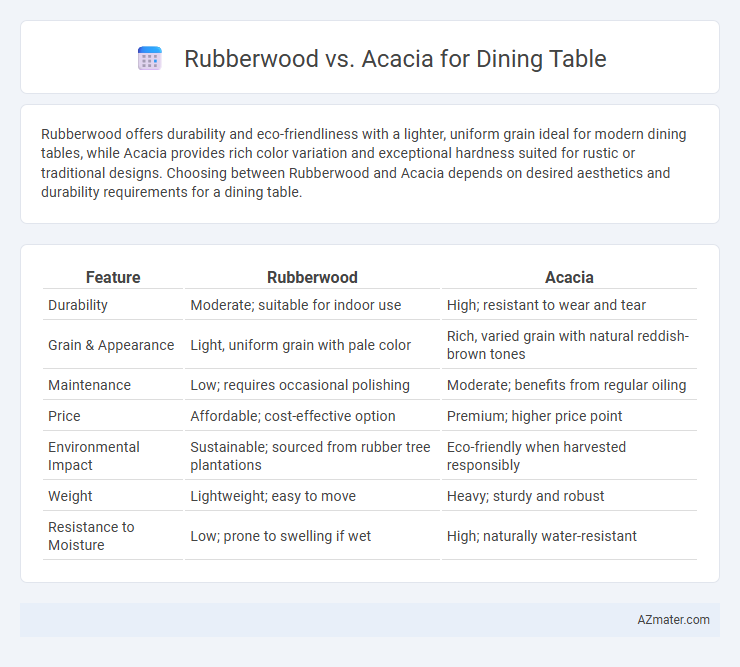Rubberwood offers durability and eco-friendliness with a lighter, uniform grain ideal for modern dining tables, while Acacia provides rich color variation and exceptional hardness suited for rustic or traditional designs. Choosing between Rubberwood and Acacia depends on desired aesthetics and durability requirements for a dining table.
Table of Comparison
| Feature | Rubberwood | Acacia |
|---|---|---|
| Durability | Moderate; suitable for indoor use | High; resistant to wear and tear |
| Grain & Appearance | Light, uniform grain with pale color | Rich, varied grain with natural reddish-brown tones |
| Maintenance | Low; requires occasional polishing | Moderate; benefits from regular oiling |
| Price | Affordable; cost-effective option | Premium; higher price point |
| Environmental Impact | Sustainable; sourced from rubber tree plantations | Eco-friendly when harvested responsibly |
| Weight | Lightweight; easy to move | Heavy; sturdy and robust |
| Resistance to Moisture | Low; prone to swelling if wet | High; naturally water-resistant |
Introduction to Rubberwood and Acacia
Rubberwood, sourced from the Para rubber tree, is a sustainable hardwood renowned for its durability, light color, and smooth grain, making it a popular choice for dining tables with a modern, clean look. Acacia, a dense hardwood native to Southeast Asia and Australia, features rich, varied grain patterns and a natural resistance to wear and moisture, ideal for long-lasting, visually striking furniture. Both wood types offer unique qualities in strength and aesthetics, catering to different preferences and interior styles for dining tables.
Origin and Sustainability
Rubberwood, sourced from the Para rubber tree primarily grown in Southeast Asia, is a highly sustainable option due to its use of plantation trees harvested after latex extraction, reducing deforestation. Acacia, native to Australia and parts of Africa, is valued for its durability but often comes from slower-growing trees, raising concerns about long-term sustainability if not managed responsibly. Both woods offer eco-friendly dining table options when sourced from certified plantations or responsibly managed forests.
Appearance and Grain Patterns
Rubberwood features a light, creamy color with subtle, straight grain patterns that offer a clean and uniform look, making it ideal for modern and minimalist dining tables. Acacia displays rich, warm tones ranging from golden brown to deep reddish hues, with distinctive swirling grain and natural knots that create a rustic and visually dynamic appearance. Choosing between Rubberwood and Acacia for dining tables depends on whether a sleek, consistent finish or a bold, textured aesthetic is preferred.
Durability and Hardness Comparison
Rubberwood offers moderate durability with a Janka hardness rating around 900, making it suitable for light to moderate use in dining tables. Acacia boasts a significantly higher hardness of approximately 1,700 on the Janka scale, providing superior resistance to dents, scratches, and wear over time. The enhanced density and toughness of Acacia ensure greater longevity and durability in high-traffic dining environments compared to Rubberwood.
Maintenance and Care Requirements
Rubberwood dining tables require regular dusting and occasional polishing with a non-abrasive wood cleaner to prevent drying and cracking, benefiting from a smooth, sealed finish that resists stains and moisture moderately well. Acacia wood demands more attentive maintenance due to its natural oils that enhance water resistance but require periodic oiling or waxing to maintain luster and protect against scratches and fading. Both woods thrive with controlled indoor humidity levels to minimize warping, but Acacia's dense hardness offers superior durability under heavy daily use compared to the softer Rubberwood.
Resistance to Stains and Scratches
Rubberwood offers moderate resistance to stains and scratches due to its dense grain and natural oils, making it suitable for everyday dining use. Acacia features a harder surface with tighter grains, providing superior durability and better resistance to both stains and scratches over time. For high-traffic dining tables, acacia's enhanced toughness ensures longer-lasting protection against wear.
Cost and Affordability
Rubberwood is generally more affordable than Acacia, making it a popular choice for budget-conscious buyers seeking durable dining tables. Acacia, known for its rich grain and hardness, commands a higher price due to its premium quality and longevity. When comparing cost and affordability, Rubberwood offers excellent value with its moderate price and sustainability, while Acacia provides a long-term investment with greater aesthetic appeal and durability.
Environmental Impact
Rubberwood dining tables offer a sustainable choice by utilizing timber from rubber trees that have exhausted their latex-producing lifecycle, reducing deforestation and promoting waste minimization. Acacia wood, while durable, often involves selective logging practices that can impact biodiversity if not sourced from certified plantations or responsibly managed forests. Opting for FSC-certified rubberwood supports eco-friendly furniture production and contributes to maintaining forest health compared to the variable sourcing standards of acacia.
Best Uses for Dining Tables
Rubberwood offers excellent durability and resistance to moisture, making it ideal for everyday dining tables that require longevity and easy maintenance. Acacia provides a rich, natural grain with exceptional hardness, perfect for statement dining tables that combine aesthetic appeal with heavy use. Both woods resist warping, but Acacia's higher density makes it better suited for larger or heirloom-quality tables.
Final Verdict: Choosing Between Rubberwood and Acacia
Rubberwood offers affordability, sustainability, and a light, uniform grain ideal for budget-conscious dining tables, while Acacia provides superior durability, rich color variations, and natural resistance to wear and moisture, making it suitable for long-lasting, high-end furniture. Choosing between Rubberwood and Acacia depends on prioritizing cost-effectiveness and eco-friendliness versus strength and aesthetic appeal. For families seeking a durable, visually striking dining table, Acacia is the preferred choice, whereas Rubberwood suits those looking for an affordable and sustainable option.

Infographic: Rubberwood vs Acacia for Dining Table
 azmater.com
azmater.com